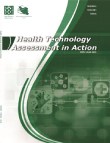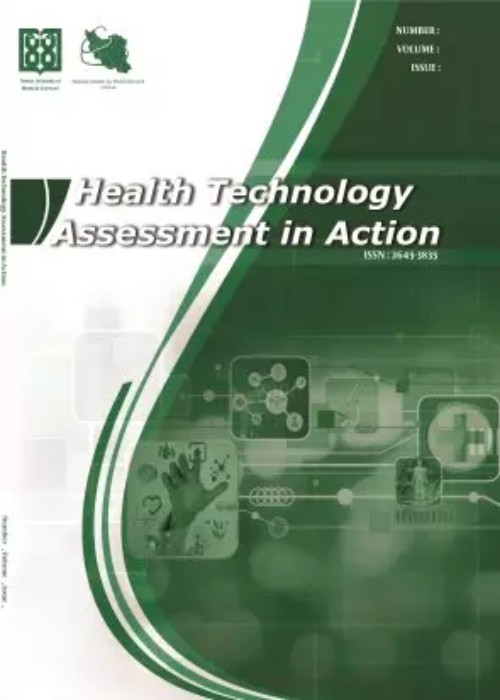فهرست مطالب

Health Technology Assessment in Action
Volume:6 Issue: 2, Dec 2022
- تاریخ انتشار: 1401/09/13
- تعداد عناوین: 6
-
-
Page 1Background
A computed tomography (CT) scan is one of the medical imaging methods that is currently used to diagnose and treat numerous diseases in a timely manner. Therefore, the widespread use of ionizing radiation in recent years has raised concerns about cancer. Given that individuals are exposed to ionizing radiation during a CT scan, they might be at a higher risk of developing cancer.
ObjectivesThis study aimed to evaluate the necessity of CT scan requests in hospitals affiliated with Birjand University of Medical Sciences, Birjand, Iran, in 2019.
MethodsThe statistical population consisted of 1,034 patients, selected by purposive sampling and relevant statistical formula. Patients’ information included gender, age, electronic code, and the imaged area. All the data were extracted by considering all ethical principles and recorded in prepared checklists. Additionally, the normality or abnormality of each CT scan was determined based on a radiologist’s report. The obtained information was analyzed by SPSS software (version 22).
ResultsOut of 1,034 patients, 547 (52.9%) and 487 (47.1%) subjects were female and male, respectively. The CT scans consisted of 687 (66.44%), 296 (28.62%), and 51 (4.93%) of the brain, abdomen-pelvis, and neck, respectively. The lowest and highest percentages of unnecessary cases belonged to the CT scans of the neck (31.37%) and brain (64.48%).
ConclusionsIn all tests, 58.6% of CT scans performed on patients were unnecessary. In addition to high doses of radiation endangering the patient’s health, these unnecessary procedures impose additional costs on the hospital and the patient.
Keywords: CT Scan, Necessity, Birjand -
Page 2Background
Hypertension is one of the most important risk factors of cardiovascular morbidity and mortality that holds a unique place in population health and health care.
ObjectivesGiven the exponential rise of high blood pressure as one of the major health problems, this study aimed to investigate the current situation and provide a strengths, weaknesses, opportunities, and threats (SWOT) analysis in the management of hypertension.
MethodsA qualitative study of 12 interviews was conducted with policymakers and managers. The sampling method was purposive sampling. Data collection was performed from January to July 2020. A thematic approach was used to analyze the data. The consolidated criteria for reporting qualitative research 32-item (COREQ-32) checklist was applied to ensure quality control in the study design, analysis, and data reporting.
ResultsA total of 12 factors were identified as SWOT. The most important strengths included universal coverage of health services, provision of team-based care, and self-care training. The weaknesses were related to the therapeutic approach, long-term planning, and continuity of programs. Cooperation of other sectors with the health system and the existence of health management training centers were noted as opportunities to better implement hypertension management programs and confront threats such as conflicts of interest between guilds and organizations and crises.
ConclusionsHigh blood pressure can be prevented. The present direction toward health-oriented policies can be changed in all sectors by taking advantage of the existing strengths and opportunities.
Keywords: Hypertension, Prevention, SWOT Analysis, Policy, Health Services -
Page 3Background
Spiritual competence means understanding the difference between spirituality and religion; and between spirituality, religion, and culture.
ObjectivesThis study aims to investigate the effectiveness of spiritual competence training on the psychological well-being of preschool teachers.
MethodsThis is a quantitative, semi-experimental, pre-test-post-test study with a control group. The statistical population included all preschool teachers in Birjand city in the academic year 2019 - 2020. Using the purposeful sampling method and following the inclusion and exclusion criteria, 40 participants were randomly selected and divided into two experimental and control groups. The experimental group received the educational package of spiritual competence in 12 sessions, and the control group did not receive any intervention. In order to analyze the data, the analysis of variance test was used with repeated measures after observing the statistical assumption.
ResultsThe mean age of the participants was 37.38 ± 7.39 years. All of the participants were female (100%). The results of the present study showed that the educational package of spiritual competence was effective for the psychological well-being of preschool teachers. The results of the test of simple effects between groups in three stages of measurement showed that there is no significant difference between the two experimental and control groups in the pre-test. Post-test and follow-up, there is a significant difference between the two experimental and control groups, and the average of the experimental group is higher in the two stages of post-test and follow-up.
ConclusionsAccording to the findings, it can be said that the educational package of spiritual competence evaluated in the present study can help in increasing the mental health and psychological well-being of preschool teachers.
Keywords: Effectiveness, Spiritual Competence, Psychological Well-being, Preschool Teachers, Birjand -
Page 4
Context:
Online health consultation services are developing, both website-based and application-based, better known as telemedicine or telehealth. Over 50% of the population can access health information easily. Telemedicine can expand healthcare services, increase accessibility, provide clinical support, save time and costs, and be efficient because it overcomes geographic barriers, offers a wide variety of communication tools, and improves patient care. Telemedicine is used to bring specialist, anti-discriminatory and effective health services closer to the interests and safety of patients to expand the quality services in healthcare centers, especially in rural areas in Indonesia.
Material and MethodsThe study design used in this article is a narrative literature review or formal review by reading the references carefully, then making a summary, drawing conclusions, and finding gaps in the manuscript adapted to the topic to be discussed.
ResultsThe significant number of problems and challenges in public health services in Indonesia can provide exciting opportunities to develop an e-health system that can help solve problems. To put a stop, the Indonesian government is advising the public and medical professionals to use telemedicine as an online public health service application between hospitals and patients.
ConclusionsTelemedicine significantly correlates with government and start-up calls and can be employed as a health service option during the COVID-19 pandemic. In this pandemic, telemedicine can improve services in terms of monitoring, evaluating, and educating patients and medical staff.
Keywords: Telemedicine, Telehealth, Covid-19, E-health -
Page 5
Context:
Health systems’ main mission is to improve society’s well-being and fulfill their health needs.
ObjectivesThis study aimed to describe the intrinsic and extrinsic events that had influenced Iran’s health system over the previous decade, as well as to identify the possible factors influencing it until 2025 and investigate their positive/negative impacts.
MethodsTo determine previous driving forces, a systematic review of electronic databases was conducted up to December 2018. Then the most frequent contributing factors were extracted and discussed in expert panels, and finally, scenarios were composed. After identifying the internal and external driving forces as well as their effects, an input-output model was designed by using a sequence of events’ scenarios. Finally, findings were presented using a scenario-based expert system model.
ResultsThe most important driving forces affecting health system’s policies included “demographic changes”, “economic changes”, “natural disasters”, “changes in population’s health status”, and “changes in the health system’s management.” Furthermore, other events such as “risks associated with emerging technologies”, “cold wars”, and “changes in personal vehicle utilization rates” may have, directly or indirectly, affected the benefits from health services, status, costs, and out-of-pocket payments.
ConclusionsIn sum, it was found possible to implement the most effective crisis management system, eliminate the negative effects of these uncertainties, and reap the most considerable benefits by identifying the factors influencing health system, determining their interrelationships and effects, as well as designing separate scenarios for all possible outcomes.
Keywords: Health System, Driving Forces, Futures Studies, Uncertainty, Trend


